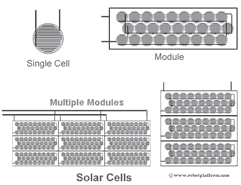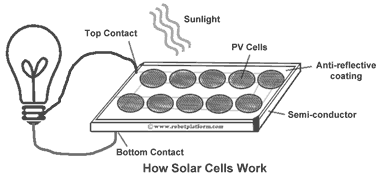Photo-Voltaic Cells
 Photovoltaic (PV) cells, generally known as Solar cells or photoelectric cells, are devices which absorb sunlight and transforms them into electricity by a method known as photovoltaic effect.
Photovoltaic (PV) cells, generally known as Solar cells or photoelectric cells, are devices which absorb sunlight and transforms them into electricity by a method known as photovoltaic effect.
Materials (mostly semiconductors) which exhibit this photovoltaic property absorb photons from light and releases electrons allowing them to freely flow through the material. The composition of these solar cells makes electrons flow in a particular direction resulting in flow of electric current. A combination of these cells in series, or in parallel results in increase of voltage or current respectively. This combination is generally known as PV array and can be designed to meet a wide variety of electrical needs.
PV cells are clean, renewable energy with unlimited potential. Robots built on solar cells may require minimum or no maintenance for years with the only prerequisite that they continuously need to receive sunlight (or light). If these solar cells are coupled with batteries and/or capacitors (usually this is a must), they can even run when there is insufficient or no light source for a few hours.
Solar cells do come with their own disadvantages. First, Solar cells are not cheap compared to rechargeable batteries which generate similar voltage and current. Secondly, the voltage and current generated from a voltaic cell with reasonable size is very minimal. But do remember that solar energy generated is renewable and does not stand with an end date. (Might still end in 5 billion years when the sun dies, and there is no other light source :)
Note: Although Solar cells are referred to devices which run on Sunlight, they can even run on electric bulbs and CFL’s. Also note that Solar cells generate DC which can directly be connected to your circuit without using coils or diodes. Image shows the basic principle of how solar cells (PV Cells) work.
BEAM robotics
BEAM robots best exploit the energy from these solar cells. BEAM is an acronym for “Biology, Electronics, Aesthetics, and Mechanics”, and BEAM robotics deals with building robots using simple components and analog circuits creating flexible and efficient robots. Few common rules for building a BEAM robot are: simple design, lowest possible number of electronic components and using energy from electromagnetic waves like heat, sunlight, radio waves etc. Amongst all the other forms of energy, solar energy is easily available and as easily be converted into electrical energy using a solar cell. If you are interested in making your own solar energy based robot, then BEAM robots are the way to go. Solar cells and panels have numerous opportunities in this field, and you can make each of your designs as unique as possible (though the underlying principle remains the same).
Do you have anything to say?
Visit the Forum to discuss, learn and share anything related to robotics and electronics !!









